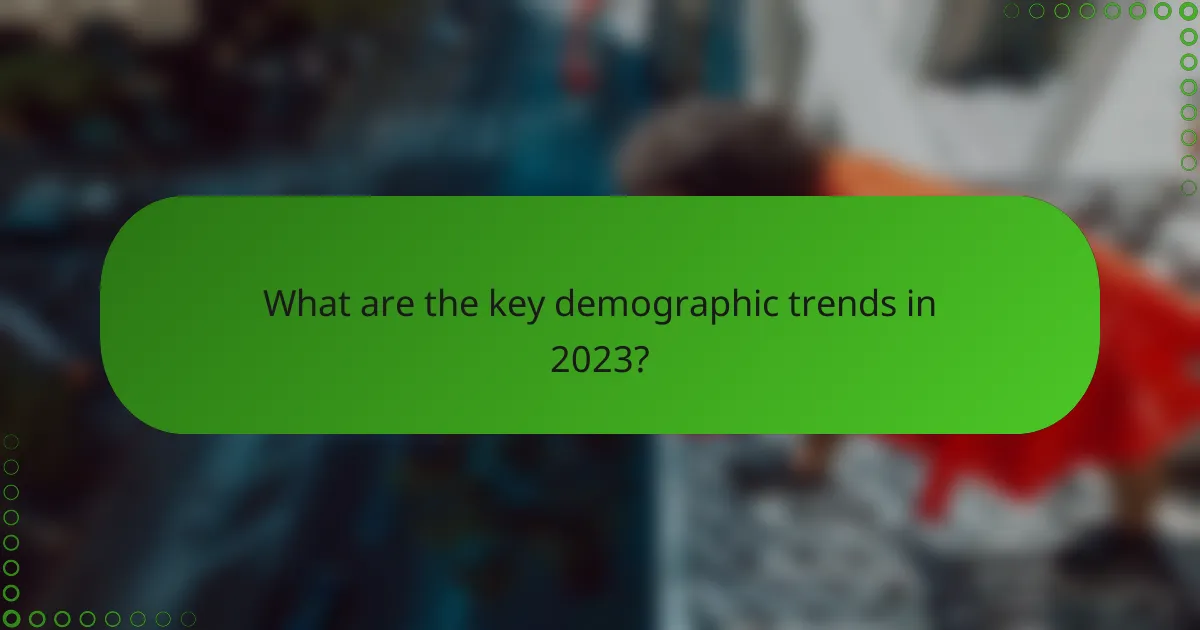Demographic data plays a crucial role in enhancing marketing strategies by enabling businesses to tailor their advertising efforts to specific audience segments. In 2023, the influence of Gen Z and increasing diversity among consumers are key trends that necessitate a shift in how companies approach their target markets. By effectively collecting and analyzing demographic information, marketers can gain valuable insights that lead to improved engagement and higher returns on investment.

How can demographic data enhance display advertising?
Demographic data can significantly enhance display advertising by allowing marketers to tailor their campaigns to specific audience segments. This targeted approach increases the effectiveness of ads, leading to better engagement and higher returns on investment.
Targeted audience segmentation
Targeted audience segmentation involves dividing a broad audience into smaller, more defined groups based on demographic factors such as age, gender, income, and location. By understanding these segments, advertisers can create tailored messages that resonate more with each group. For instance, a luxury brand may focus on high-income individuals aged 30-50, while a budget-friendly product might target younger consumers with limited disposable income.
To implement effective segmentation, consider using tools like Google Analytics or social media insights to gather demographic information. This data can help identify which segments are most likely to engage with your ads, allowing for more strategic ad placements.
Improved ad relevance
Improved ad relevance is achieved when advertisements are aligned with the interests and needs of specific demographic groups. When ads are relevant, users are more likely to engage with them, leading to increased click-through rates. For example, a fitness brand advertising to health-conscious individuals will likely see better results than a generic ad targeting a broad audience.
To enhance ad relevance, utilize demographic data to customize ad content, visuals, and messaging. A/B testing different versions of ads for various segments can also help determine what resonates best with each group.
Increased conversion rates
Increased conversion rates occur when targeted advertising leads to more users taking desired actions, such as making a purchase or signing up for a newsletter. By leveraging demographic data, advertisers can create highly relevant ads that speak directly to the motivations of their target audience. This targeted approach can lead to conversion rates that are significantly higher than those achieved through generic advertising.
To maximize conversion rates, ensure that your landing pages are also tailored to the demographic segments you are targeting. Consistency between the ad and landing page content can enhance user experience and drive conversions. Regularly analyze conversion data to refine your strategies and improve results over time.

What are the key demographic trends in 2023?
In 2023, key demographic trends include the rising influence of Gen Z consumers and an increase in diversity among consumer profiles. These trends are reshaping market strategies and requiring businesses to adapt to changing preferences and values.
Rise of Gen Z consumers
Gen Z, those born from the mid-1990s to the early 2010s, are becoming a significant force in the consumer market. This generation values authenticity, sustainability, and social responsibility, often prioritizing brands that align with their beliefs.
To effectively engage Gen Z, businesses should leverage social media platforms, particularly TikTok and Instagram, where this demographic spends considerable time. Brands that create interactive and visually appealing content are more likely to capture their attention.
Increased diversity in consumer profiles
Diversity among consumer profiles is growing, reflecting broader social changes. This trend includes variations in ethnicity, gender identity, and socioeconomic status, leading to a more complex marketplace.
Marketers should recognize that a one-size-fits-all approach is ineffective. Tailoring messages and products to resonate with specific cultural backgrounds and experiences can enhance brand loyalty. For instance, using inclusive language and diverse imagery in advertising can help reach a wider audience.

How to collect and analyze demographic data?
Collecting and analyzing demographic data involves gathering information about specific population characteristics to understand trends and target audiences effectively. This process can be accomplished through various methods, each offering unique insights and considerations.
Surveys and questionnaires
Surveys and questionnaires are direct methods for collecting demographic data from individuals. They can be distributed online or in person and typically include questions about age, gender, income, education, and other relevant factors.
When designing surveys, ensure questions are clear and concise to avoid confusion. Consider using a mix of multiple-choice and open-ended questions to gather both quantitative and qualitative data. Aim for a sample size that is representative of your target population to enhance the reliability of your findings.
Social media analytics
Social media analytics provides insights into demographic data by analyzing user interactions and profiles on platforms like Facebook, Instagram, and Twitter. These platforms often offer built-in analytics tools that can reveal information about user age, location, interests, and behaviors.
To leverage social media analytics effectively, regularly monitor engagement metrics and audience insights. This data can help tailor content and marketing strategies to better resonate with specific demographic segments. Be mindful of privacy regulations, such as GDPR, when using personal data from social media.
Third-party data providers
Third-party data providers offer comprehensive demographic data that can enhance your understanding of target markets. These companies aggregate information from various sources, including public records, surveys, and online behavior, to provide detailed demographic profiles.
When choosing a third-party provider, evaluate their data accuracy, coverage, and compliance with relevant regulations. This data can be particularly useful for businesses looking to expand into new markets or refine their marketing strategies based on demographic insights. Consider the costs involved and the potential return on investment when utilizing these services.

What tools are available for demographic targeting?
Demographic targeting tools help marketers identify and reach specific audience segments based on various characteristics such as age, gender, location, and interests. These tools provide insights that enable more effective advertising strategies and improved campaign performance.
Google Ads Audience Insights
Google Ads Audience Insights allows advertisers to analyze their audience’s demographics and interests based on search behavior and online activity. This tool provides data on age, gender, parental status, and household income, which can be used to create targeted ad campaigns.
To leverage Google Ads Audience Insights effectively, start by reviewing the demographics of your existing customers. Use this information to refine your targeting settings, ensuring your ads reach the most relevant audience segments. Regularly monitor performance metrics to adjust your strategies as needed.
Facebook Audience Insights
Facebook Audience Insights offers detailed information about your audience on the platform, including demographics, interests, and behaviors. This tool helps businesses understand who their followers are and how to engage them effectively.
Utilize Facebook Audience Insights by exploring the data on your page’s followers and potential customers. You can create custom audiences based on specific criteria, such as location or interests, to tailor your ad campaigns. Keep in mind that privacy regulations may affect the data available, so stay updated on compliance requirements.
Adobe Audience Manager
Adobe Audience Manager is a data management platform that helps marketers build audience segments using first-party and third-party data. It enables businesses to create detailed profiles and target specific demographics across various channels.
When using Adobe Audience Manager, focus on integrating data from multiple sources to enrich audience profiles. This can enhance your targeting precision. Be mindful of data privacy and ensure compliance with regulations like GDPR when handling personal information.

How to create effective demographic profiles?
Creating effective demographic profiles involves identifying relevant characteristics of your target audience and utilizing data to inform your marketing strategies. This process helps businesses tailor their offerings to meet the specific needs and preferences of different demographic groups.
Identify key attributes
To build a comprehensive demographic profile, start by identifying key attributes such as age, gender, income level, education, and geographic location. These factors can significantly influence consumer behavior and preferences.
Consider segmenting your audience based on these attributes to create more targeted marketing strategies. For example, a company selling luxury goods may focus on high-income individuals aged 30-50 living in urban areas.
Utilize data visualization tools
Data visualization tools can enhance your understanding of demographic data by presenting it in a clear and interpretable format. Tools like charts, graphs, and heat maps allow you to quickly identify trends and patterns within your audience.
For instance, using a bar chart to compare the purchasing habits of different age groups can reveal valuable insights. This visual representation helps in making data-driven decisions and communicating findings effectively to stakeholders.

What are the challenges in using demographic data?
Using demographic data presents several challenges, including data privacy concerns, accuracy, and the potential for misinterpretation. Organizations must navigate these issues to effectively leverage demographic insights for targeting and decision-making.
Data privacy regulations
Data privacy regulations are crucial when handling demographic data, as they dictate how personal information can be collected, stored, and used. Laws such as the General Data Protection Regulation (GDPR) in Europe and the California Consumer Privacy Act (CCPA) in the United States impose strict guidelines that organizations must follow.
Compliance with these regulations often requires implementing robust data protection measures, such as obtaining explicit consent from individuals before collecting their data. Organizations should regularly review their data practices to ensure they align with current legal standards and avoid potential fines.
Additionally, understanding the nuances of these regulations can help businesses tailor their marketing strategies effectively. For instance, companies operating in multiple jurisdictions must be aware of varying requirements and adapt their data collection methods accordingly to remain compliant.









